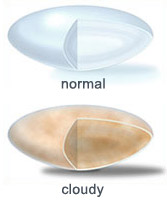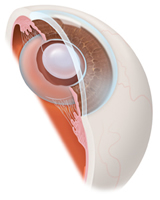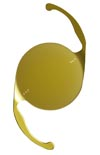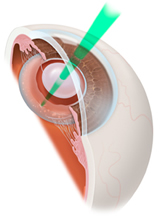


Cataracts cause progressive, painless loss of vision. The lens clouds naturally as we age, so people over the age of 65 usually see a gradual reduction of vision. No one is exactly sure what causes cataracts. In younger people they can result from an injury, certain medications, or illnesses such as diabetes. Prolonged exposure to ultraviolet light may also play a role in the formation of cataracts. Studies have also shown that people who smoke cigarettes have a higher risk of developing cataracts than non-smokers.
Although cataracts usually can develop without apparent pain, some indications that a cataract may be forming are:
If visual impairment interferes with your ability to read, work, or do the things you enjoy, then you will want to consider cataract surgery. Cataract surgery is a relatively painless procedure. It has a very high success rate and more than 90 percent of cataract surgery patients regain useful vision.
 The natural lenses of the eyes are naturally very clear but may become clouded due to time or other factors. This cloudiness cannot be “cleaned” off in any way, so the entire lens must be replaced through surgery if the case is severe. Cataract surgery is quite common and has been perfected over many years since its inception.
The natural lenses of the eyes are naturally very clear but may become clouded due to time or other factors. This cloudiness cannot be “cleaned” off in any way, so the entire lens must be replaced through surgery if the case is severe. Cataract surgery is quite common and has been perfected over many years since its inception.
The procedure itself consists of the removal of the clouded lens through a small slit in the cornea made by the surgeon. This can be accomplished through one of two ways. The first is through emulsifying the cataract through ultrasonic waves and suctioning the remaining material out. If the lens is so cloudy that it cannot be broken up, the surgeon will remove the stubborn lens nucleus in one piece through the slit before vacuuming the rest of the soft lens out.
In both cases, a new artificial intraocular lens (IOL) is placed in the vacated capsule. These new lenses are generally perfect replacements for the old, allowing the patient to achieve improved vision. In most cases, sutures are not needed, as the surgical wound will heal quickly on its own.



Intraocular lens implants for cataract patients
Common issues incurred after surgery include mild discomfort, itchiness and crusting discharge. These annoyances should disappear within a few days. It is highly recommended that you refrain from rubbing your eyes for several weeks. The doctor will prescribe eye drops to facilitate healing, which should be complete within two months. The doctor should be contacted immediately if you experience a sudden loss of vision, nausea, swollen eyes, light flashes, floaters or severe pain.
 Intraocular lenses are used to correct vision problems during cataract surgery by replacing the old, damaged lens with an artificial lens that clears up and corrects vision, often leaving patients with little to no dependence on glasses. While cataract surgery corrects cloudy lenses, it still leaves patients with astigmatism with distorted vision. Toric IOLs are specially designed to correct astigmatism along with overall vision during cataract surgery, offering complete vision correction.
Intraocular lenses are used to correct vision problems during cataract surgery by replacing the old, damaged lens with an artificial lens that clears up and corrects vision, often leaving patients with little to no dependence on glasses. While cataract surgery corrects cloudy lenses, it still leaves patients with astigmatism with distorted vision. Toric IOLs are specially designed to correct astigmatism along with overall vision during cataract surgery, offering complete vision correction.
Before Toric IOLs, people with astigmatism would need to undergo corneal refractive surgery after their lenses were implanted, or would remain dependent on glasses or contact lenses. The advanced Toric IOLs correct the imbalance caused by an irregular cornea shape in patients with astigmatism. There are several different types of FDA-approved Toric IOLs, including AcrySof® Toric Lenses, which can correct up to 3 diopters of astigmatism.
 During cataract surgery, your doctor replaces the clouded, blurry area of the lens with an artificial one to correct vision. However, after surgery, many people experience a gradual clouding on the covering of the new lens, a condition known as after cataract or secondary membrane. Clouding is the most common complication of cataract surgery and can cause blurred vision to return, but a solution is available to treat this side effect.
During cataract surgery, your doctor replaces the clouded, blurry area of the lens with an artificial one to correct vision. However, after surgery, many people experience a gradual clouding on the covering of the new lens, a condition known as after cataract or secondary membrane. Clouding is the most common complication of cataract surgery and can cause blurred vision to return, but a solution is available to treat this side effect.
A procedure called a posterior capsulotomy, using an Nd: YAG laser, can be performed to remove the back lining of the lens capsule and let light pass through to the retina. The laser cuts a hole in the back lining and helps remove cloudiness in the lens.
The capsulotomy can be performed in your doctor's office and is a painless procedure that does not require any anesthesia. It is considered a safe procedure and most people only experience short-term increased eye pressure.
To learn more about Cataract Surgery, please call 718-638-2020 today to schedule a consultation.